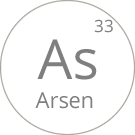
Drinking water limits: 0,010 mg/l (10 µg/l)
- No color
- No taste
- No odor or other manifestations
- Chronic poisoning (neurological disorders – limb tingling, hematopoietic disorders, scaling of the skin, pigment spots, higher skin cancer risk)
Removal of arsenic from watery
- Principle: adsorption on ferric materials
Arsenic is a metal found in some minerals, from which it can be released into the water. It is typically found in groundwater from deep wells (often the case of artesian wells). It does not occur in concentrations that cause immediate poisoning and death, but long-time drinking of arsenic water leads to chronic poisoning and health problems.
For arsenic removal, co-precipitation with iron can be used (if the iron in water is present in sufficient quantity), or it can be adsorbed on an iron hydroxide filler. Such cartridge has limited capacity and life (about three years). It is only for single use and it needs to be replaced after the capacity is exhausted.